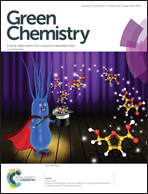Gold and palladium oxidation/complexation in water by a thioamide–iodine leaching system†
Abstract
This paper concerns the oxidative dissolution ability of a thioamide/iodine leaching system in water towards gold, palladium and silver metals in powder in view of a potential application in the recovery process of these metals from electrical and electronic waste equipment (E-waste). The leaching mixture composed of equimolar amounts of thioamide 3-methyl-benzothiazole-2-thione and I2 in water can oxidize/complex gold and palladium metals in powder in order to form the complexes [AuI(mbtt)2]I3 and [PdII(mbtt)3I]I3. Considering the mild conditions under which the processes were performed ([I2] = 1.14 × 10−3 M, T = 20 °C, pH = 5.0, leaching time = 24 h), the obtained oxidation yield of Au0 and Pd0 are to be considered satisfactory with values of 65% and 69%, respectively. No oxidation was observed for the silver powder. The oxidising/complexing properties of the leaching mixture mbtt + I2 were interpreted considering the formation of the mbtt–I2 adduct that features, as a consequence of the S-donor to I2 interaction, a charge separation between the bridging and terminal iodine atoms in the fragment S–Ib–It. The feasibility of recovering gold from the complex [AuI(mbtt)2]I3 was verified by performing a cementation with magnesium powder.



 Please wait while we load your content...
Please wait while we load your content...